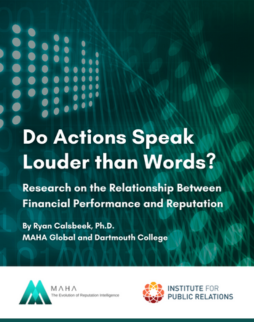
This is the second in a series of blog posts for Measurement Month.
Measurement, measurement, measurement. This term still plagues our industry, and is often in the spotlight as one of the areas where our profession needs improvement. Twenty-five years ago, under the leadership of Jack Felton, the Institute for Public Relations formed the Measurement Commission to help address issues and offer research support for measurement and related topics. This Commission still provides research and thought leadership, as frustrations with the current state of measurement continues to grow.
Earlier this year, the University of Southern California and The Holmes Report* released the results of a global survey that found reach (68%), impressions (65%), and content analysis of articles (64%) were the most frequently used measurement and evaluation metrics. Unfortunately, 30% also reported advertising value equivalency was still used (I won’t address the serious methodological issues with this as it has been addressed many times by other articles and posts). As evidenced by the results, our industry still has a lot of work to do.
First, the metrics we use, or suggest as gold standards, are largely focused on the media. While this does give a partial picture, it does not give us a complete one. Working with and monitoring media, both traditional and social, are only a small part of what we do. Also, many individuals do not publish their thoughts or opinions on social media, especially internal audiences. Our industry focuses on media measurement to the exclusion of other methods such as surveys, experiments, and even predictive modeling made possible by the increased access to big data.
Next, when we do focus on the media, we give in to what Gary Sheffer, an IPR Trustee and former CCO of GE, calls “success theater,” where we pat ourselves on the back for earning unrealistic metrics (if you ever have seen a report where a limited program in a segmented geographic market earns billions of impressions, you know what I’m talking about). When we offer these unrealistic metrics, we set ourselves up for failure, as we are always trying to raise this bar of inaccuracy higher.
Finally, our industry throws around the buzz term “insights,” using it interchangeably with “data” and “metrics.” While some research experts think the term “research” is outdated and “insights” may be a better term, I still think research is a good approach. The research process is important. The ability to do research allows us to see the big picture and to create appropriate methodologies for collecting data. The data and findings allow insights to be generated. Measurement is the ability to quantify data or streamline qualitative data. Data, though, are not insights. Insights are an extra step in the process where the data is interpreted and application to the business is made that may have not been made otherwise.
And we can’t forget the importance of non-numbers – qualitative findings are extremely helpful as well. Pairing a focus group or interviews with surveys is helpful to glean insights and can answer some of the “why” questions that quantitative methods may not be able to answer. However, relying on smaller samples as the gospel with qualitative research can create problems with generalizations.
What is missing from the “Where are we now?” conversation about data, measurement, and insights, is the real purpose of what we are trying to do. Our purpose should not be to try to prove the value of our profession or worth compared to other organizational departments. That should not be the focus. Rather, we should use these tools to make adjustments, do a better job, and help us to set benchmarks for our goals and objectives. Research and insights should save time and money, and help support our decisions by also narrowing options and pinpointing issues. Somewhere, we have fallen off the path of purpose in regards to measurement, and with a little help, we can straighten ourselves and head back in the right direction.

Tina McCorkindale, Ph.D., is the President and CEO of the Institute for Public Relations. Formerly, she was a university professor and research analyst. Follow her on Twitter @tmccorkindale.
* The annual Global Communications Report is conducted by USC Annenberg’s Center for Public Relations, — in conjunction with The Holmes Report, the Institute for Public Relations, the Global Alliance for Public Relations and Communication Management, the International Association for Measurement and Evaluation of Communication, the PR Council, the Worldcom PR Group and PRSA.



